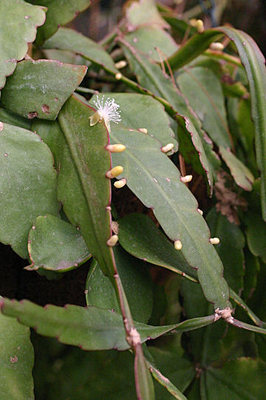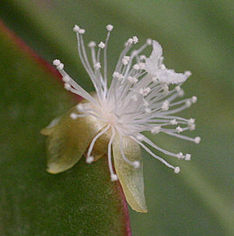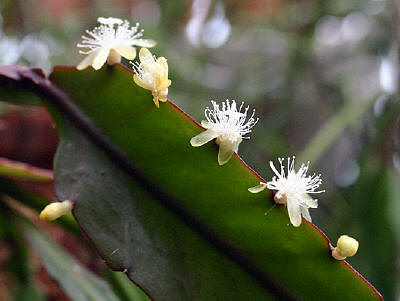See Calvente thesis 2010
5 RHIPSALIS ELLIPTICA G. Lindb. ex K. Schum.
in Martius, Fl. Bras. 4(2): 293. 1890.
TYPE: BRAZIL. Sao Paulo: Santos, "prope Sororocaba in adscensu
montis Espigao do Curupira ad arbores silvae primaevae", Mosen
3630 (lectotype in Barthlott and Taylor .1995: S!).
? Rhipsalis chloroptera F.A.C.Weber in Bois, Dict. Hort.
2: 1045. 1898.-TYPE: BRAZIL. Sao Paulo: Santos, before 1898, Weber
s.n. (not found).
Rhipsalis elliptica var. helicoidea Loefgr., Arch.
Jard. Bot. Rio de Janeiro 2:44. 1917.-TYPE: Loefgren, Arch. Jard.
Bot. Rio de Janeiro 2: Tab. XVI. 1917 (lectotype, here designated).
Notes; The original description of R. elliptica in the Flora
Brasiliensis by Schumann (1890) included a typo in the locality of
the collection Mosen 3630 (cited), there designated as one of the
syntypes of R. elliptica. The collection Mosen 3630 was erroneously
published as "Sorocaba" (Sao Paulo, Brazil), instead of
"sororocaba" (Santos, Brazil) as written in the specimen
label.
When R. chloroptera was described, a collection from Santos
(Weber s.n.) was selected as the type. Even though this collection
could not be located, a detailed analysis of the original description
of R. chloroptera allowed us to determine that R. chloroptera
is very likely a synonym of R. elliptica. The fact that
the type locality of R. chloroptera (Santos, Brazil) corresponds
to the same type locality of R. elliptica supports our hypothesis.
R. elliptica var. helicoidea was originally described by
Loefgren (1917) as being characterized by an helicoidal disposition
of the branches. However, this morphological trait is quite variable
and also commonly found in Rhipsalis elliptica. As a matter
of fact, a single specimen of Rhipsalis elliptica can include
branches with helicoidal and plane dispositions, making the recognition
of both taxa inappropriate.
The original circumscription of R. elliptica was based on
only a few specimens, all of which presented deep magenta fruits.
A careful examination of a higher number of specimens of R. elliptica
indicated that R. elliptica is much more widespread and morphologically
variable than originally thought. In particular, the deep magenta
fruits can be white when immature. Furthermore, several specimens
that perfectly match the description of R. elliptica in terms
of vegetative and floral traits, presented white fruits, indicating
that fruit color is variable within this species. Variation in fruit
color is not uncommon in Rhipsalis.
For example, R. teres and R. lindbergiana present
specimens with either whitish, pinkish or magenta. Hence, we do not
consider fruit color as being sufficient to diagnose species in Rhipsalis
and adopt a broader circumscription of R. elliptica.
The new circumscription of R. elliptica also includes specimens
with white fruits, instead of treating those specimens as a separate
taxon (R. oblonga) like previous treatments (Barthlott &
Taylor 1995; Hunt et al 2006; see notes under R. oblonga
for further information). Furthermore, the white fruited individuals
differ from R. oblonga by the larger stem segments with crenate
margins and small areoles, which are diagnostic characters of R.
elliptica. Two subspecies are recognized here.
5.1. RHIPSALIS ELLIPTICA subsp. ELLIPTICA
Epiphyte in shaded habitat, 0.4-1.5 m long, branching apical or sub-apical.
Stem segments flattened in longitudinal section, 0.3-2 mm diam, medium
green, dark green or reddish, slightly succulent to succulent, dimorphic
or monomorphic, midrib 2-3.5 mm diam (up to 6mm diam in primary segments),
cylindric; primary stem segments 12.5-24 cm long; wings 2-3, 0.5-2
cm wide; secondary stem segments 7-16 cm long, base wide attenuate
to attenuate, apex attenuate, wide attenuate, rounded or rarely truncate;
wings 2, 0.5-4.5 cm wide, margin crenate or slightly crenate, plane
to undulate, with 1-6 mm projections. Areoles between margin projections,
0.8-3 cm apart, first of segment 1-5 cm distant from segment base;
when sterile 1 mm diam or less, glabrous; when fertile 1.2-2.5 mm
diam, glabrous or with 1 acicular scale, rarely with scarce hairs
at margin, 1-2 flowers/fruits. Flowers 11-14 mm diam; pericarpel 3-5
X 2.5-4.5 mm, cylindric, greenish or pinkish, glabrous; with 2-4 sepaloid
tepals, 0.4-2 mm long and 5-7 petaloid tepals, 3-8 X 2-5 mm, wide
elliptic, elliptic or oblong, patent to reflexed, yellowish or greenish,
sometimes external with reddish apex, apex rounded, straight to slightly
cucullate, margin straight or curved inwards. Style 4.5-5 mm long;
stigma with 3-5 lobes, 1.5-2.7 mm long, ligulate, spreading. Ovules
in 3-4 incomplete septa, funicle short to long (0.5-1 mm long). Stamens
60-100, 2-7 mm long, internal shorter, internal erect and external
facing inwards, whitish. Nectary 0.5-0.8 mm long. Fruit 5.5-7.5 X
5-6 mm, globoid to elongate, deep magenta to white, glabrous. Figures
4: B, C, H; 6: B, C.
Notes; Rhipsalis elliptica subsp. elliptica is
distinct from R. elliptica subsp. microflora by
the larger flowers with longer petaloid tepals and stamens. All specimens
with deep magenta fruits are circumcribed under this subspecies
Habitat and distribution: Occurs widespread in southern and southeastern
portions of the Atlantic Forest (Brazil). Figure 5.
Rhipsalis elliptica Lindberg in Martius,
Fl. Bras 4: 293. (1890).
Desc from Hunt 2006.
plant pendent, up to 2 m, dark green or tinged magenta to purple; basal
branches up to 35 cm, usually 3 winged; branch segments naked, mostly
flattened, margins crenate, 8-14 (-18) x 3-6 (-8.5) cm, 2-2.5 mm thick
away from midrib, more or less elliptic; flowers 1-3 (-5) per areole,
1/2-2 cm diam; inner tepals 5, pale to golden yellow; stigma 3-4, up
to 3.5mm; fruit globose to elongate, up to 7 x6 mm, deep reddish pink
 R. elliptica (copyright KAF, Kew 2006)
R. elliptica (copyright KAF, Kew 2006) 

